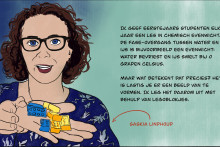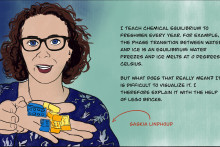‘These two glass tubes each contain a polymer dissolved in water,’ says doctoral candidate Van Lente. He holds two small vials, each containing a clear fluid. ‘When we combine these solutions, the polymers aggregate and form a gel-like complex that doesn’t dissolve in water.’ To prove his case, van Lente and Lindhoud pipet the two solutions in a vial containing water. Within seconds, a whitish swirl appears, making the solution opaque. The two polymers have merged and turned into an insoluble, gel-like compound. This forms the basis of the revolutionary protein separation method that Lindhoud and van Lente developed. Tomorrow, 17th of March 17th, Van Lente is defending his PhD thesis on the topic.

Mimic principles
Separating molecules has always been an important part of chemistry. Since most chemicals occur as mixtures, scientists need to isolate the substance needed from the mixture to obtain pure chemicals. Some separations currently can be done using simple filtration, or high-tech machinery, like chromatography. Membranes can also effectively separate mixtures of different compounds.
‘The chemical basis of life rests on the ability of biological cells to separate compounds’
‘But nature is also excellent in separating mixtures,’ Lindhoud says. ‘The chemical basis of life rests on the ability of biological cells to separate compounds. The cell membrane is designed in such a way that it allows some substances to pass, while other cannot. For example, body cells can selectively take up or excrete certain substances to sustain life.’
Cytosol
Recent studies have revealed that these cells are even more complicated than previously thought. Cells contain a nucleus and cytosol, the fluid containing specialized structures, with a specific function. Some of these so-called organelles generate energy, while others are responsible for protein synthesis. But high-resolution microscopy has revealed that the cytosol itself also is highly structured and contains droplet-shaped structures. These are hypothesized to form different compartments with a different selectivity for chemical substances.
‘Further research has shown that these compartments inside the cytosol are made up of proteins that are sticking together due to differences in charge between the different protein chains,’ Lindhoud explains. ‘As a result, these protein chains, or polymers, form droplet-shaped structures that allow certain molecules to enter and become attached, while others are kept outside. This inspired us to try to mimic these principles and make such structures.’

Improved molecular separation
Mimicking the droplet structures as found in the cell’s cytosol could offer many possibilities for new and improved molecular separations. Instead of proteins, Lindhoud and her colleagues used different polymers. Polymers are long, chain-like, molecules with repeating links. Depending on the type of polymer, these molecules can have different charges. By experimenting with such differently charged polymer chains, the scientists managed to construct a similar-looking droplet structure as was found in the cytosol of cells.
‘The principle is quite simple,’ Lindhoud says. ‘We used a negatively-charged polymer and mixed it with a positively charged polymer in water. These oppositely charged polymers subsequently attracted each other and when used in a certain ratio, formed a gel-like droplet structure, just like the protein polymers in the cell’s cytosol.’ The next step was to find the best polymer mix that could be used for an optimal separation.
Challenging task
The scientists decided to use egg white powder from the supermarket for their separation tests. Eggs contain a complex mixture of different proteins, including the enzyme lysozyme. By using different polymer mixtures, they tried to separate lysozyme from the rest of the proteins. A challenging task, since the lysozyme made up only a small fraction of the total egg protein mixture. Eventually, the most efficient polymer mix was the negatively charged polyacrylic acid mixed with the positively charged poly-allylamine: when egg powder was dissolved in water and mixed with these two polymers, a polymer gel was formed and the lysozyme selectively attached to this gel.
‘By simply pouring the water off, we could get rid of all other proteins, while lysozyme was attached to the polymer gel,’ Lindhoud explains. ‘To release the lysozyme from the gel, we added clean water and by increasing the acidity of the water, the charge of the polymer chains also changed, and a small part of the gel dissolved, releasing the lysozyme.’ This successful separation was excellent news for the scientists and as icing on the cake, the lysozyme remained fully functional and hadn’t changed structurally during the separation.

Flexibility
According to Lindhoud, their method is really useful due to its flexibility: by using different types of polymers, with different lengths and charges they can vary endlessly and adapt their method for different purposes. Now the basic principle of the new molecular separation method was established, the next challenge was to adapt the method for specific applications, where different molecules need to be separated from each other.
‘There is an increasing demand for plant proteins to substitute animal protein’
Currently, the team is working on adapting their successful method for application in the food industry. ‘There is an increasing demand for plant proteins to substitute animal protein,’ Lindhoud says. ‘But many plants use bitter-tasting polyphenols, like tannins, as a defense against fungi and insects. These should be removed first to make the proteins suitable for human consumption.’ Therefore, there next project involves the selective removal of these polyphenols from plants. To develop their method, they decided to use acorns and chestnuts because they are usually plentiful and relatively easy to harvest and contain proteins and polyphenols. Lindhoud: ‘Unfortunately, this year had a really poor acorn and chestnut crop, so hopefully, next year will be better!’








